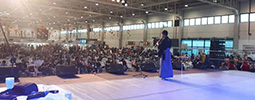April 2022
- PREVIOUS
- NEXT
Shakuhachi’s Timeless Timbre Brings Rich Experience to Global Audiences

Kuroda Reison (left) performs with the chamber music group mdi ensemble at a recital in Milan, Italy 
Kuroda Reison (center) with local taiko drum group Ishindaiko in Londrina, Brazil

Shakuhachi player Kuroda Reison 
A local paper in Londrina, Brazil, reporting on a joint performance by Kuroda Reison and local taiko drum group Ishindaiko 
Solo performance at the Curitiba Immigrant Festival in Brazil

Shakuhachi player Kuroda Reison visited six countries over the course of two months in 2019 as a Japan Cultural Envoy, sharing this Japanese instrument.

The shakuhachi is a traditional Japanese woodwind instrument held vertically like a recorder. The tone is produced by blowing across a hole at the top of the instrument known as the utaguchi and pressing or lifting fingers on the five holes of the body: four on the front and one on the back. The shakuhachi is typically made from the root end of bamboo cut to about 54 centimeters long.
The instrument has been widely used for background music in samurai dramas and movies, and as an accompaniment to Japanese folk songs. Because of that, it has often been seen as a folksy, old-fashioned instrument. Shakuhachi player Kuroda Reison aspired to “break this stereotypical idea of the instrument and demonstrate to people all over the world that while the shakuhachi can perform classical performances of ancient music, it is also an instrument that resonates with people of the twenty-first century.”
According to Kuroda, people from outside Japan have come to love the shakuhachi over the last fifty years or so. The World Shakuhachi Festival, which began in Okayama Prefecture, Japan, in 1994, continues to be held approximately once every four years in different parts of the world, including Boulder and New York in the United States, Sydney, Australia, and London, the United Kingdom.
It is said that Japanese contemporary composer Takemitsu Toru’s November Steps is one of the major reasons for the shakuhachi coming to be known worldwide. The piece premiered in 1967 under the direction of conductor Ozawa Seiji, with biwa*, shakuhachi, and the New York Philharmonic, in New York. Shakuhachi was played by the renowned player Yokoyama Katsuya.
Kuroda states that he would not have chosen to become a shakuhachi player if he had not encountered this composition. “Someday, I hope to compose and perform a masterpiece for the shakuhachi that fascinates people around the world, just like November Steps.”
Kuroda was appointed as a Japan Cultural Envoy in 2019, and over the course of two months, he visited China, Italy, Brazil, France, Germany and Portugal, and performed around 34 times, including at lectures and workshops.
He performed in a joint performance with the world-famous chamber music group mdi ensemble in Milan, Italy, performing the flute part for Mozart’s Flute Quartet on the shakuhachi. He commissioned a work to be performed in Italy by the young Japanese composer Kimura Erika for the same ensemble. He also asked Urabe Yuki, another young Japanese composer, who was studying at the Conservatorio di Milano, to compose a piece for the ensemble. By asking young composers, Kuroda hoped to convey to them how the shakuhachi, which has been categorized as an ancient instrument, can also be successful as a modern instrument.

Kuroda comments that “the audience in Milan listened intently so as to not miss a single sound of the compositions by these young women. There was a strong sense of unity between the performers and the audience.”
In Berlin, Germany, Kuroda played to a full house. As the performance ended, there were shouts of “Bravo!” and loud whistles from the audience. Kuroda claims that he was moved by the audience’s desire to genuinely enjoy an unknown genre of music and the shakuhachi’s timbre. He was thrilled, sensing that the shakuhachi was accepted by people outside of Japan as a timeless instrument that could touch the hearts of people today.
He also performed together with local choro and baiao (forms of Brazilian instrumental popular music) musicians in Sao Paulo, Brazil, playing bossa nova on his shakuhachi, communicating with the local performers through their instruments. In Curitiba, Brazil, he played a solo in an arena-sized venue. In Londrina, Brazil, he performed the Yosakoi Naruko Odori (festival dance music from Kochi Prefecture) with local taiko drum group Ishindaiko as well as Japanese children’s songs on his own. He received tremendous ovations there as well.


Kuroda’s experience as a Japan Cultural Envoy has greatly influenced his musical career. “I felt a stronger desire to write new compositions and take on joint performances with a variety of people to further expand the potential of the shakuhachi as an instrument that resonates with the hearts of people from around the world.”
* A traditional Japanese instrument with ancient roots in China and southern Asia. Has a similar shape to the lute, an ancient European instrument. See Highlighting Japan, August 2021: https://www.gov-online.go.jp/eng/publicity/book/hlj/html/202108/202108_11_en.html
- PREVIOUS
- NEXT

